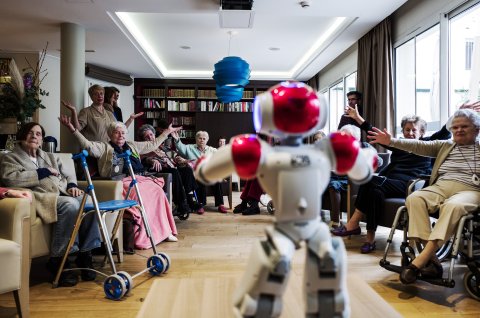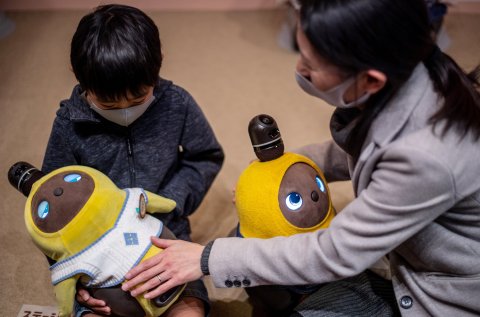The explosion of progress in artificial intelligence in recent months has surprised even the scientists and engineers who specialize in applying AI to real-world tasks. “A few years ago I never would have imagined we’d advance this far this soon,” says Zhe Jiang, a University of Florida researcher who studies industrial applications of AI.
The recent excitement—and concerns—over this technology were ignited when several major companies released stunningly capable new programs in swift succession, including OpenAI’s ChatGPT, Microsoft’s Bing and Google’s Bard. These “large language models” are programmed to pore over trillions of words of text from the internet to learn how to produce very human-like text and images on their own in response to plain English questions and requests.
These and other AI tools are expected to have big consequences for the economy and spill over into virtually every sphere of life, from education to entertainment to health. People also will lose their jobs, while others become more productive.
“What AI can do may seem magical now, but soon it’s going to seem commonplace,” says Rowan Curran, an analyst at research firm Forrester who focuses on AI. “Just as we couldn’t have imagined the impact that ridesharing apps like Uber would have on cities and transportation, we’re not imagining all the ways that AI will change things.”
Nobody can say exactly what changes AI will bring, but experts agree that they’ll be big and far-reaching. In the coming years, AI tools are widely expected to change the way most people live and work.
Better Medical Care
In April, a study published in the journal Nature showed that an AI program was as good as or better than human experts at spotting heart problems in patient ultrasound images. That’s just the latest in an ongoing stream of research that suggests AI is already skilled enough to match or exceed human doctors at catching cancers and other disorders by scanning images and tissue samples and combing through medical records.
AI is also good at transcribing and summarizing patient encounters and sifting through vast technical literature to root out drug interactions and other facts that could be critical to patient treatments. A new system from startup Hippocratic AI, designed to interact with patients, even boasts an empathetic bedside manner. It has outperformed other AI programs—and many human clinicians—on more than 100 certification exams, including nursing, dietetics and urology. These programs are only going to get better, and combined with their lower cost and an ongoing shortage of doctors, the future of medicine is looking very AI.
Some pharmaceutical companies are already relying heavily on AI to help find promising new drugs. For instance, PsychoGenics, a pharma research company specializing in drugs for psychiatric disorders, is improving on the inefficient, inexact and costly process of testing new psychiatric drugs on mice, which typically takes five years. By using AI instead of lab technicians to observe the effects of new drugs on mice, the company can test more drugs with greater accuracy at a tenth the cost and two years faster. (The results are always confirmed by human experts, the company says.)
Four drugs found via PsychoGenics’ AI are now in clinical trials, including one promising schizophrenia drug entering a phase III trial this year. “There are limits to what a human can observe,” says PsychoGenics CEO Emer Leahy. “AI is the only way we could have spotted the right patterns of behavior” in the lab mice.
A Helping Hand to Seniors
Eldercare robots have already stepped in to help some of the 56 million Americans over the age of 65, who face many health and wellness challenges. Ongoing breakthroughs in conversationally adept AI programs such as ChatGPT will soon make them become better companions.

Philippe Lopez/AFP/Getty
The help is greatly needed. Each year, three million elderly people in the U.S. wind up in emergency rooms after a fall, according to the Centers for Disease Control and Prevention. Of those who sustain fractures, half don’t live more than a year. The U.S. is also facing an “epidemic” of social isolation, the Surgeon General said in 2017, along with the high cost and short supply of eldercare workers. Families often cannot provide the help that’s needed.
Eldercare robots have already taken up some of the slack, even without incorporating the recent AI advances. Robots already watch over seniors with electronic eyes, beam video alerts to family, fetch small items, answer questions and set up reminders. Some of them can already start conversations with seniors, prompting them for childhood and other personal recollections, and then reporting the results to family members.
Soon, however, the power of such devices to interact with people will improve enormously. Caregiving and companion robots equipped with the latest AI can provide “contextual empathy,” says Forrester’s Curran. “They can tell the difference between a senior who’s rummaging through a drawer, and one who’s struggling to open a drawer,” he explains.
To What Am I Speaking?
Robocalls have long been an annoyance, but the next time your phone rings you may not be able to tell if you’re talking with a human or a machine. Telemarketing is something that AI will be especially good at, notes Robert Seamans, an associate professor at New York University’s business school who studies AI’s impact. When Seamans and colleagues analyzed which types of tasks AI programs are going to excel at over the next few years, telemarketing came out at the top. “That’s a job that involves the one, very specific task of making sales, usually by reading from a script,” he explains, making it an easy lift for AI.
Those in need of legal help may also soon depend on AI’s ability to handle certain tasks. According to a March report from investment bank Goldman Sachs, AI will be capable of taking on nearly 45 percent of legal work in coming years. That’s because much of what lawyers and paralegals do today involves poring through oceans of documents to search out specific information and summarize the results, as well as writing out standard contracts.
“AI can do these routine tasks quicker than lawyers,” says Brandie Nonnecke, who co-directs the Center for Law and Technology as well as the AI Policy Hub at University of California, Berkeley. But, Nonnecke adds, AI “isn’t ready to handle advanced legal activities, like identifying what’s relevant to a case and what isn’t, and overseeing legal strategies. It can’t understand the issues at hand in complex cases.”
Some legal firms are using AI to provide guidance to their clients. California online legal services firm DoNotPay offers AI assistance that defendants can use to fight parking tickets and other minor legal violations without having to hire a lawyer. The company had even been planning to have its AI take the lead in a live court case by feeding the program’s output in real time to a human lawyer who would read it out loud. But in January the company was forced to withdraw its plans under threats from state bar associations to disbar any lawyers who participated.

Philip Fong/AFP/Getty
Soon, millions of office workers will be working alongside AI programs. Human resources departments are using AI to zip through thousands of online resumes in seconds in search of candidates with skills and experience that match job openings. A survey of 250 human resource managers found 92 percent of them intend to bring in more AI. Forrester found that AI cuts an average of 11 hours of human HR work a week.
Most administrative employees will soon find themselves sharing cubicles, metaphorically at least, with AI programs aimed at marketing, financial, customer-service and production applications, among others. Companies now employ AI to make on-the-fly decisions about ad placement, predict shifts in costs and sales and spot problems in manufacturing quality control. AI systems at some companies are resolving customer service issues without human involvement, and online used-car site CarMax is using AI to analyze and summarize customer reviews, notes Seamans. “The program provides much better insights into what people think about when they buy a car,” he says. As AI programs get better at communicating, they will essentially become coworkers sharing workloads and making suggestions.
Robot Workers
Robots are teaming up with blue-collar and other skilled workers. Many of the two million people in the U.S. who work behind the wheel of a car, truck or heavy-equipment vehicle are already sharing their seats with AI programs, whether it’s self-driving cars or autonomous construction vehicles. John Deere promises to release self-driving tractors soon. Packages will be brought to your doorstep in the not-too-distant future by AI-powered drones or delivery robots, two technologies that Amazon have been piloting for several years.

Jean-Christophe Verhaegen/AFP/Getty
Robots have long been a routine sight at factories, but forthcoming humanoid robots such as Tesla’s Optimus and Sanctuary AI’s Phoenix will work shoulder-to-shoulder with people as robo-cooks, robo-stockers and robo-gardeners. At Sam’s Club, robots now clean floors and look for missing or misplaced items on shelves. Hospitals use robots to disinfect their rooms. Your next home might be built with AI-powered help, thanks to massive 3D printers that can construct parts of a home or small building layer by layer out of concrete.
AI-powered tools and machines have been working the fields alongside farmworkers, notes the University of Florida’s Jiang, helping to speed every stage of the growing cycle and easing a longstanding skilled-labor shortage via smarter equipment that can be controlled by less-skilled workers. It may not be long before the surgeon that operates on your heart or knee is an autonomous robot. In May, Monogram Orthopaedics demonstrated a robot that performed knee surgery on a cadaver entirely under remote control.
Writing and Coding
The Hollywood writers strike, which began on May 2, is mainly about pay, but a secondary issue is how much scriptwriting work AI should be allowed to take. Programs like Google’s Bard and OpenAI’s GPT-4 can easily crank out scripts that seem much like the work of a human, and they can do it to suit almost any style, setting or theme, for little or no cost, almost instantly. “We have a real issue on our hands,” says Marc Guggenheim, a writer and producer who has been behind hit shows such as Carnival Row and Arrow. “It isn’t necessarily one in the very short term, but maybe as soon as a year from now it will be.”

David McNew/Getty
AI cannot match the quality of human writers, says Guggenheim. “AI scripts tend to be bland and uninteresting,” he says. “It’s improving quickly, but there will always be a human element, an X factor, that even the best AI won’t be able to imitate.” The bigger concern, he says, is that AI will take over some of the less-demanding writing jobs for which standards are lower, but which many writers depend on for a chunk of their income. That work includes rewrites, rough drafts, scripts for game and reality shows, and TV-show spinoff novels. “Directors who want a fast overnight rewrite for tomorrow’s show may just hand it over to ChatGPT,” he says. “That will make AI a direct threat to how writers are respected in Hollywood.”
It may not be all bad for writers, however. In the near future, they might be able to write a script, feed it to an AI program and produce a finished TV show or even movie—no producer, director or actors needed. “AI can already produce pretty good videos based on written descriptions,” says Guggenheim, referring to AI video generators such as those offered by Synthesia and other companies.
There’s one line of work that AI may be ready to take over from humans: writing the code underlying apps, websites and other software. “Entry-level coding jobs, at least, can be replaced by ChatGPT,” says Jiang. But that doesn’t mean coders need to worry about being laid off, he adds. Because there’s a perennial shortage of coders, he says, companies are far more likely to keep hiring them to oversee the AI tools, spelling out assignments and checking the resulting work. In one study an AI tool working alongside a human coder was able to speed up the coding process by 55 percent compared to a human working alone.
As AI tools get better at understanding non-technical directions, even people with little or no coding experience will be able to get a tool to produce a new mobile app, or a computer program that helps with business or professional tasks. “AI lowers the bar for more of us to become software developers,” says Curran. Professional developers will keep their jobs, he predicts, but they’ll end up focusing on more sophisticated software projects AI can’t handle alone.
A Possible Upside
It’s too soon to panic over AI’s potential for stealing jobs, says Berkeley’s Nonnecke. “We’ve been going through various technology revolutions since homo sapiens first walked upright,” she says. “We’ll adapt and evolve to this one, too. People will find new ways to do their jobs creatively, taking advantage of AI instead of being replaced by it.”
The advent of an AI-powered workforce could actually produce big dividends. Because AI can do so much so quickly and inexpensively, companies could see enormous boosts in efficiency that enable them to offer better products at much lower costs, to consumers’ benefit. Companies will likely in turn see a boost in revenues—though whether that bounty spills over into the whole economy or just makes executives and investors richer while millions of workers lose their jobs is an open question.
Services could improve, too. For instance, AI customer-service representatives may actually be able to solve customers’ problems. Phone apps could be tailored to each person’s needs. Home assistants could discover new music that clicks with each person’s tastes, watch over elderly relatives and hunt down discount food supplies and hard-to-get sports and concert tickets. “AI could make a lot of our interactions better,” says Curran. Because it will have contextual empathy, it will recognize what you’re doing and what’s going on around you, and anticipate what you want or need based on that understanding.
The changes are expected to be transformative, which makes them difficult to predict. “This is where we were during the early days of the internet,” says Seamans. “It ended up dramatically changing the way we work, play and interact. It will be the same with AI.”


